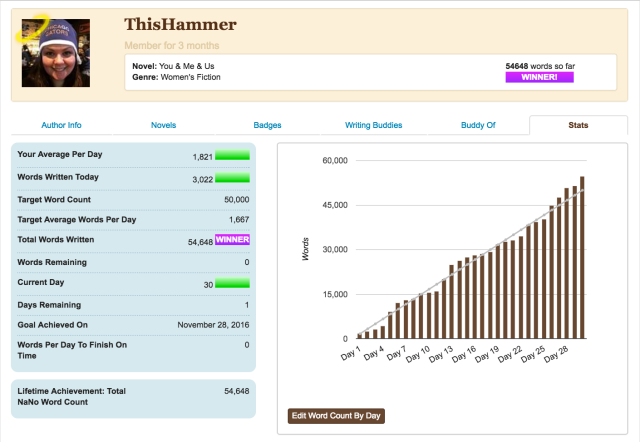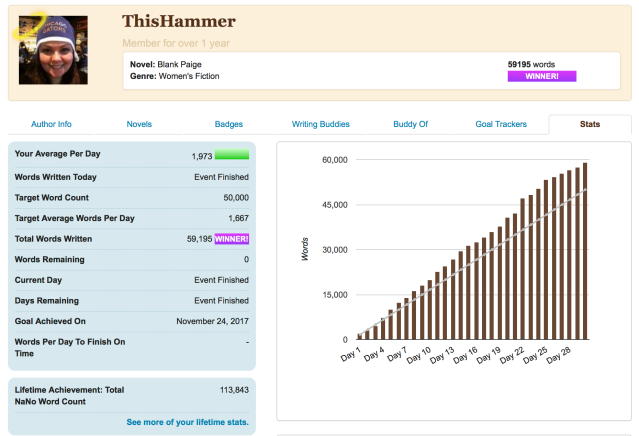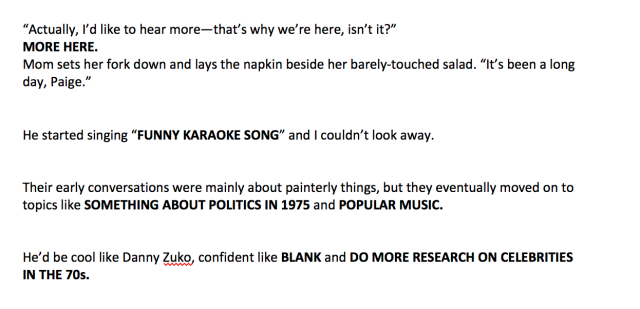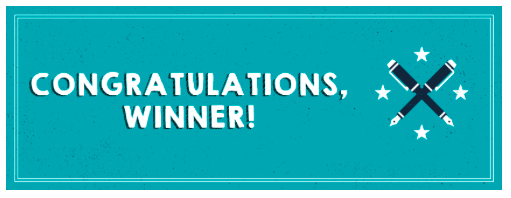For years, I was fascinated by NaNoWriMo (National Novel Writing Month) from a distance, because the idea of trying to write 50,000 words in thirty days seemed impossible. Every time I came close to signing up or learning more, I talked myself out of it.
Until last year.
In November of 2016, I took the leap and tried NaNoWriMo for the first time. Not only did I “win”, but I crossed the 50,000 word finish line two days early. When it was over, I was both happy that I accomplished the goal, and pretty sure I’d never do it again.
But then July came around and I let myself get talked into doing Camp NaNoWriMo, the more causal, set-your-own-goal summer version. I used that time to finish the fourth draft of my NaNo ’16 project, YOU & ME & US.
Then suddenly it was November again, and while the idea for my next novel had been rolling around in my head for a few months, I had yet to do more than a little outlining and brainstorming. Still, I signed up for NaNoWriMo ’17, feeling a lot less prepared than I had been the first time.
But I did it again. And I “won” again. Two days earlier than the last time.
Although the end results were the same, the experience and the final output of my two NaNoWriMos couldn’t have been more different. So I thought it might be interesting to look at the similarities and differences between the two years.
They both started with champagne.
I read a post in an online forum that it was a thing to have a glass of champagne and start writing at midnight on October 31st, right when the clock strikes November. I loved the idea, so a tradition was born! I just wrote a few hundred words each time, but there was something exciting about going into the morning of November 1st with a little head start.
Words were written every day.
The first chart below shows my word count progress in 2016, the second one was for this past November. Just looking at the two, it’s pretty obvious how different the journeys to 50,000 words was.


In 2016, I made the commitment to write every day, but I wasn’t specific about the number of words I had to get down. Some days I just wrote a few hundred, other days, a few thousand. The chart shows how I was constantly playing a game of falling behind, catching up, getting ahead and falling behind again.
This year, I made the same commitment of writing every day—but I made the goal a bit more specific. While the official NaNo goal is 1,667 words a day, I decided to make my personal goal 1,000 words a day. I hit that word count goal most, if not every day in November, which helped me reach and stay above the official NaNo progress tracker.
In the beginning, there was an outline.
The NaNo world classifies writers in two camps. You’re either a “plotter” or a “pantser.” A plotter, as the name suggests, starts with a written plot, while a “pantser” starts with a blank page and from there, they “fly by the seat of their pants”.
I always thought I was a combination of the two, but this past NaNo taught me that I am much more of a plotter than I realized.
The parts of BLANK PAIGE, my NaNo 17 project, that weren’t really planned or thought out were much more challenging to write. For me, the pantsing part comes in when my characters decide to take a left turn when I’d been planning on a right. Sometimes those detours go well, and when they don’t, the words end up in the “scraps” document I always have on hand.
The outline for my 2016 NaNo project was a lot more fleshed out than the 2017 version. I had a chapter-by-chapter outline that I stayed pretty close to, except for a few of those detours. The main reason for that?
One started with familiar characters. The other did not.
My 2016 NaNo project, YOU & ME & US, featured the same characters from my first novel, about fifteen years after I thought their story had ended. Not only did I know their back story, I had been writing about it for more than a decade. By this point, the characters were almost like real people. Once I realized how the rest of their story was supposed to go, it unfolded pretty easily for me. I just had to write it.
BLANK PAIGE, my 2017 NaNo project, was the complete opposite. While I knew the gist of the story (which was inspired by an incident that happened to a friend) the characters were strangers to me. I had done a little ‘getting to know you’ work using Story Genius, but the characters still weren’t very well-formed in my mind.
It wasn’t until I started writing that the characters started coming to life, one scene at a time.. At the moment, I’m about 73,000 words into this first draft, and I’m still in the first-date phase with a few of the characters. But we’re getting there.
One “final” first draft was polished-ish. The other will not be.
I’m a perfectionist. I can’t help it. I will re-write a sentence seventeen times until I’m happy with it. But during NaNoWriMo, every word counts. And if you spend an hour writing and re-writing the same twelve words, you will end the hour only having written twelve words.
For NaNo 16, I was just starting to embrace the idea of a ‘shitty’ first draft. But I didn’t want it to be that shitty…so I started every writing session reading over what I’d written the day before and polishing it up a bit. I didn’t do any major edits, but I definitely re-wrote a lot of sentences.
At the end of December (I kept writing every day until the draft was finished) I had a pretty complete manuscript. It only took one round of real edits before I felt like it was ready for my first group of beta readers.
This time, however, I have fully embraced that shitty first draft philosophy. Since I’m figuring so much of this story out as I go, I’m being a lot easier on myself. I’m almost viewing this draft as a book-length outline—I’ll go in later and fill in the missing pieces and start to round out both the characters and their story.
Here are a few actual lines from my WIP to show you just how shitty I’m talking about:

I’m totally 100% okay with how terrible those words are. Leaving the notes within the sentences as I wrote gave me permission to keep going instead of spending 30 minutes debating what characters should be talking about during dinner, wasting who knows how many hours going down the rabbit hole of songs that would have been funny for karaoke in 2015. or doing research on what celebrities were hot in 1975.
Those details will come later. For this draft, I just needed to get the story out.
One draft was written in Word. The other, in Scrivener.
For the last two years, people in my writing groups have been telling me I should give Scrivener a try. And every time I told them, “It’s just not for me” or “I prefer Word.”
But then I had a friend (Thank you, Lainey!) kindly spend fifteen minutes taking me through her Scrivener document, showing me all the ways the program was amazing. After that, I became an official convert.
I don’t use all the functions and features (probably because I don’t know about them yet!), but the ones I do use have made such a big difference.
The first thing that has been a big help is the “Project Targets” feature. I set my daily target to be 1,000 words, just like my NaNo goal. Every day when I open the document, I see a little bar telling me how far I’ve gone and how far I have left to go. Some days I hate that bar, but it’s kept me going at least until I see it turn green!
The other big benefit of Scrivener was one I didn’t realize until NaNo was over.
When writing in Microsoft Word, the most obvious tracker of length is the number of pages your document is. The average page is 250 words, so even if you write 1,000 words, it’s only about 4 pages. And between four pages or 1,000 words—the latter feels and sounds a lot more impressive.
When writing in Scrivener, you have absolutely no idea how many pages something is unless you take the time to compile the document or copy and paste it into Word (which I admit I’ve done once or twice).
I didn’t realize how big of a difference it made until I compiled my Scrivener doc and saw just how much I had written. I figure it’s kind of like covering the tracker on a treadmill—sometimes not knowing how many tenths of a mile you’ve walked makes it easier to keep going. When you aren’t so focused on the distance, you might keep walking even farther than you planned.
There was never “enough” time.
I used to be precious about my writing. When, where, how—you name it, I had ways that I liked to do it. As evidenced by the number of #AmWriting Starbucks pictures you’ve seen if you follow me on Instagram, I like writing at Starbucks.
Truth be told, I prefer the coffee at Dunkin’ Donuts, but there’s something about the vibe at most Starbucks locations that just fits my writing needs. There’s just the right amount of background noise—too much and I can’t focus, too little and I find myself looking for distractions—there’s coffee, and there are writing friendly tables. As my friend Nancy will tell you, I’m very picky about my writing tables. I prefer square or rectangle to round and would rather not sit at high-tops. I know it’s weird, I just like having my feet on the ground.
But when you’re working a very busy job and trying to make time and meet writing goals in a month that’s filled with holidays (including your birthday!), you have to let some of that go.
Thanks to NaNo, I’ve gotten pretty good at finding ways to trick myself into the fiction-writing headspace I need to be in. I imagine it’s pretty similar to the way some people can fall asleep anywhere. I’ve never been one of those people, but now I can write almost anywhere—the train, in the car at the airport cell-phone lot, my kitchen table, the kitchen counter, my couch, my bed, and sometimes (after-hours only), my desk at work.
Because I write for a living, I am very careful about separating my fiction writing from my work/advertising writing. But sometimes, I’ll take advantage of the quiet office space at the end of the day, and instead of going home where I’ll be distracted, I stay at work an extra hour, put on my ‘Saved at Starbucks’ Spotify playlist and get those words in!
The last difference made the biggest difference.
The first year I participated in NaNoWriMo, I was mostly in it alone. The next year, I wasn’t at all.
Once I made the initial decision to try NaNoWriMo, I joined a few Facebook groups, including one with other writers in the Chicago area. There were a few hundred members in the group, many who knew each other and had been doing it for years. There were newbies like me as well, and while I did go to one meet up and post a few times, I didn’t fully embrace the group.
I had a few other writing friends who were also doing NaNoWriMo, but the NaNo message boards and chat features aren’t the best. So other than commenting on a few posts, I was pretty much on my own.
This past year, I’ve become much more involved in WFWA (Women’s Fiction Writers Association), and I have established a wonderful writing tribe. Within that group, a handful of writers were also doing NaNo, so we decided to make our own little Facebook group.
For some reason, it just clicked, and made all the difference in the world. Instead of just being accountable to myself, I was accountable to a group who were all in the same boat. We supported, encouraged and grumbled and cheered each other on. And we organized it in a way that gave us a reason to check in each day.
Every day, I posted a picture inspired by the writing process, from cups of coffee to pencils to celebratory champagne and every day, 20ish writers would comment, checking in and sharing the progress (or lack of progress) they made that day.
Because we had a few “rebels” in the group who had goals different than the 50k new words, people shared the number of words they wrote, then number of words they edited or the number of hours they sat in front of their computer with their #ButtInChair (which explains the inspiration behind the picture for Day 16.)
We had another great daily post that kept us going where a handful of us would post anything from a sentence to a scene that we had worked on that day. It was a great way to push ourselves to write something worth sharing, and to get to know each other better through our writing.
We loved the group so much that we decided to keep a modified version of it going, all making the commitment, as our name says, to Write Every Damn Day.
Oops. There’s one more.
Crossing that 50k finish line was amazing. But it’s not really a finish line. Not by a long shot. As I’ve mentioned before in other posts, most novels are closer to 100k than 50k. So while it’s not a done deal, it’s definitely something to celebrate.

After the 50k words, there will hopefully come another 50k-ish words, then rounds of revisions and beta readers and hopefully, someday, this (and my other) projects will make it out into the world for people to read. But if I’ve learned one thing over the last year+ of this journey, it’s that the publishing process is even more difficult than the writing one!
But I won’t stop writing, and I won’t stop trying to get published. Because I don’t really have a choice. Writers have to write—and come next November, chances are, I’ll be back in the NaNo trenches trying to write 50k words yet again.
(Want to learn more about NaNo? Here are a few blog posts I wrote during my first NaNo experience from the beginning, the middle and the end.)







That’s my girl. I am very proud of you. And to put this out on January 1 is the great start to a new year.
LikeLike